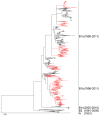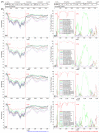Molecular epidemiology of coxsackievirus A16: intratype and prevalent intertype recombination identified
- PMID: 24340064
- PMCID: PMC3858299
- DOI: 10.1371/journal.pone.0082861
Molecular epidemiology of coxsackievirus A16: intratype and prevalent intertype recombination identified
Abstract
Coxsackievirus A16 (CVA16) is responsible for nearly 50% of all the confirmed hand, foot, and mouth disease (HFMD) cases in mainland China, sometimes it could also cause severe complications, and even death. To clarify the genetic characteristics and the epidemic patterns of CVA16 in mainland China, comprehensive bioinfomatics analyses were performed by using 35 CVA16 whole genome sequences from 1998 to 2011, 593 complete CVA16 VP1 sequences from 1981 to 2011, and prototype strains of human enterovirus species A (EV-A). Analysis on complete VP1 sequences revealed that subgenotypes B1a and B1b were prevalent strains and have been co-circulating in many Asian countries since 2000, especially in mainland China for at least 13 years. While the prevalence of subgenotype B1c (totally 20 strains) was much limited, only found in Malaysia from 2005 to 2007 and in France in 2010. Genotype B2 only caused epidemic in Japan and Malaysia from 1981 to 2000. Both subgenotypes B1a and B1b were potential recombinant viruses containing sequences from other EV-A donors in the 5'-untranslated region and P2, P3 non-structural protein encoding regions.
Conflict of interest statement
Figures




References
Publication types
MeSH terms
Substances
Associated data
- Actions
- Actions
- Actions
- Actions
- Actions
- Actions
- Actions
- Actions
LinkOut - more resources
Full Text Sources
Other Literature Sources

